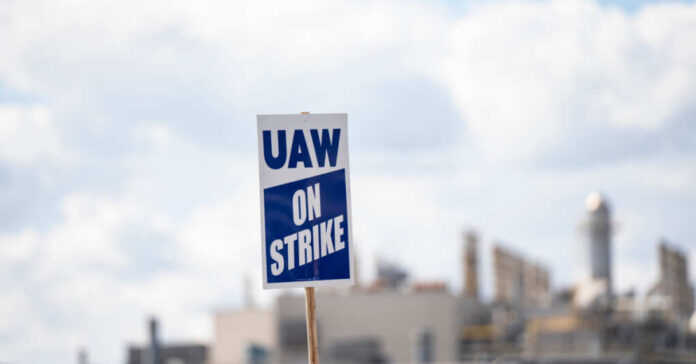President Joe Biden is grabbing his picket sign and heading to the frontlines with striking United Auto Workers in a play to garner media attention as well as the support of those adversely affected by his intensely “anti-gas-powered automobile stance.”
Critics were quick to point out that former President Donald Trump announced plans to go to Michigan prior to Biden’s sudden decision. President Biden’s visit to a suburban Detroit picket line appears to be nothing more than a carefully orchestrated photo opportunity. While he portrays himself as a champion of labor unions, his actions suggest a different story. His visit follows his June decision to approve more than $9 billion to fund three EV battery plants in Tennessee and Kentucky, both of which are right-to-work states.
During the ongoing UAW strike, Biden has used strong rhetoric, claiming that the auto companies have not done enough to meet union demands. However, his reluctance to explicitly endorse specific UAW requests, such as a 40% wage increase and full-time pay for a 32-hour workweek, raises questions about the depth of his commitment.
In a contrasting move, instead of participating in the second Republican primary debate, Trump plans to visit Michigan to meet with striking auto workers. While White House officials dismiss the idea that Trump influenced Biden’s decision to visit Michigan, the timing suggests that Biden’s actions may be more about political optics than genuine support for workers.
For Biden, it’s an attempt to recover from his current dismal polling. Biden’s 2020 path to the White House was significantly influenced by the labor movement in the United States. According to initial post-election survey results, union members overwhelmingly supported Joe Biden and Kamala Harris, with a 58% vote share. This was in stark contrast to the public, which favored Biden by only three points. Among union members, Biden had a substantial 21-point lead. This strong union support played a crucial role in mobilizing the vote, especially in key states like Wisconsin, Michigan, and Pennsylvania.
But Biden’s current policies are harmful to the UAW, which has withheld endorsement for both Trump and Biden. Biden labels himself as “the most pro-union” president to ever hold office, but Trump points out that Biden’s green energy policies threaten the jobs of the very workers he alleges to support.
Donald Trump has a strong base of support among white working-class voters, including many autoworkers. The former president’s argument about Biden’s intention to dismantle the UAW holds merit, as electric vehicles (EVs) generally require fewer workers, and non-unionized factories like Tesla are prominent in the EV industry. However, the outcome of Trump’s message remains uncertain. He has urged autoworkers to break ranks with their leadership, but the autoworkers appear to be standing firm.
The current situation is laden with tension and significance, not only for the labor movement but also for the presidential race. Both candidates, Trump and Biden, are vying for the support of blue-collar workers and share a connection with those on picket lines. This dynamic adds an extra layer of drama to the ongoing political landscape.
It’s important to point out that union members can, and often do, break with leadership. Individual union members have diverse political beliefs and may vote based on personal values and priorities. While union leaders provide guidance, members’ votes can vary due to factors like regional differences, economic concerns, and social issues.
This means that while UAW’s leadership may ultimately be a sure thing for Biden, it’s not a guarantee that union members will see it the same way.
As President Biden takes center stage on a Detroit picket line, the political theater is in full swing. Yet, beneath the carefully orchestrated photo opportunity, a more complex narrative emerges. Biden, once hailed as a pro-union champion, finds himself at odds with the very workers he aims to support, facing skepticism from the United Auto Workers.
In contrast, Donald Trump, with his appeal to autoworkers and concerns about Biden’s green energy policies, adds a layer of uncertainty to the political landscape. Trump is facing challenges of his own with the UAW. His stance on trade agreements and tariffs could be considered harmful to automakers, especially given the significance of the auto industry in international trade. Additionally, unions historically back Democratic candidates.
In this high-stakes drama, the union’s role remains pivotal, highlighting the diversity of perspectives within their ranks and underscoring the challenges both candidates face in winning over this critical constituency.


















